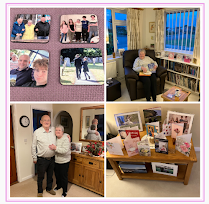12 Nov 2010
Inactive week radiowise
This week I've been very inactive on the radio because we have had our grandson's 3rd birthday party here with his French grandparents (neither of whom speak English) staying along with his mum and dad. Still, a lovely time was had and he got lots of nice presents. By the way, he now knows the difference between square waves and sine waves and loves going "oo oo", which means fiddling with the audio oscillator and scope.
Labels:
grandson
7 Nov 2010
Looking for G3XIZ on 8.9719kHz VLF
 |
| Looking for G3XIZ on 8.9719kHz - maybe a faint trace?? |
5 Nov 2010
Real QRP on 8.760kHz today
| Weak trace at 1.5km from the 320mW TX by earth mode |
 |
| 320mW 8.760kHz QRSS3 transmitter |
How to be stupid ...follow me
Just managed to blow up my 8.76kHz TX by putting the supply the wrong way round: took out the 4060, 5-Vreg and several electrolytics.The TDA2002 was also damaged. Rebuilt the keyer and freq gen part OK but now need to source a new audio PA IC or module. Now I have a reverse protection diode across the pins! You learn the hard way.
In the meantime I may try even lower power with my trusty 2N3904/3906 1W PA and see if this can be seen at the NT carpark (1.5km) and at Lord's Ground Farm (5.1km). Also, as this PA is efficient and runs cold for ever I could try 1 day on, 1 day off, QRSSSSS and see if more distant people could copy it using very narrow bandwidth reception as per DK7FC's tests.
In the meantime I may try even lower power with my trusty 2N3904/3906 1W PA and see if this can be seen at the NT carpark (1.5km) and at Lord's Ground Farm (5.1km). Also, as this PA is efficient and runs cold for ever I could try 1 day on, 1 day off, QRSSSSS and see if more distant people could copy it using very narrow bandwidth reception as per DK7FC's tests.
4 Nov 2010
QRP at AA1TJ
It's time to remind people of the wonderful circuits and ideas at Mike Rainey AA1TJ's site. Always full of amazingly simple designs that really work. See http://www.aa1tj.com/radio.html
Labels:
aa1tj
3 Nov 2010
UK first transmission on the Dreamer's Band (8.760kHz)
| Signal received at 5.1km from home QTH on 8.760kHz VLF |
 |
| 8.76kHz TX |
Labels:
8.76khz,
dreamers band,
earth mode,
vlf
2 Nov 2010
500kHz interference
In the last few days several stations across Western Europe have noticed a strong wideband signal that is severely impacting reception between 498-502kHz. This appears to be a NATO test transmission for a marine data system that may be introduced in the near future.
Labels:
500kHz,
marine data,
nato
8.75kHz VLF transmitter ready
My small 4W, crystal stabilised, 8.750kHz VLF transmitter is now ready to test having fitted the crystal and 4060 divider this morning. All being well I'll test this Wednesday or Thursday when I've optimised my soundcard settings on the PC used at the RX end.
1 Nov 2010
Preparations for Dreamer's Band Tests
This evening I modified my loop antenna and VLF preamp to better optimise them for use at 8-9kHz and also modified my E-field probe antenna. So, on the RX side I think I'm ready with the hardware. By Wednesday I hope to have the 4060 divider behind the HF crystal to give me a stable 8.750kHz source for the TX. If the weather is reasonable I should be out testing in the Fens locally by Wednesday or Thursday.
Labels:
dreamers band,
vlf
28 Oct 2010
First "Dreamers Band" UK test next week
As is required by my NoV, I asked the Met Office for permission to transmit in the 8.7 - 9.1kHz band next week Tuesday to Friday 0800-1800 GMT and they've confirmed it's OK.
My initial tests will be a repeat of the earth-mode tests done at 838Hz earlier in the summer using the same kit with 4W to 20m spaced earth electrodes. I'll also test with the 70m sq wire loop antenna used for 136 and 500kHz. The most likely TX frequency will be 8.750kHz (4.480MHz xtal divided by 512). I'll find a means of getting on 8.970kHz later. Modes will be 12wpm CW and QRSS3 initially.
These local tests are not in the same league at all as DK7FC's and I'm only expecting a few kilometres at best. However, it is a start and it allows me to test TX and RX equipment and different PC packages.
My initial tests will be a repeat of the earth-mode tests done at 838Hz earlier in the summer using the same kit with 4W to 20m spaced earth electrodes. I'll also test with the 70m sq wire loop antenna used for 136 and 500kHz. The most likely TX frequency will be 8.750kHz (4.480MHz xtal divided by 512). I'll find a means of getting on 8.970kHz later. Modes will be 12wpm CW and QRSS3 initially.
These local tests are not in the same league at all as DK7FC's and I'm only expecting a few kilometres at best. However, it is a start and it allows me to test TX and RX equipment and different PC packages.
Labels:
8.75khz,
dreamers band,
nov,
vlf
Subscribe to:
Posts (Atom)




